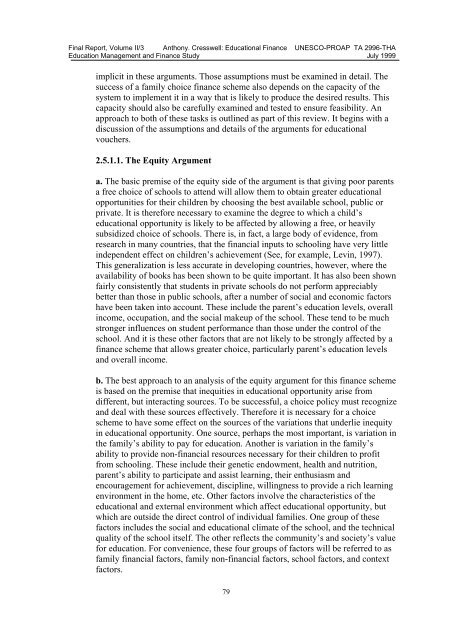Educational Finance in Thailand - UNESCO Bangkok
Educational Finance in Thailand - UNESCO Bangkok
Educational Finance in Thailand - UNESCO Bangkok
You also want an ePaper? Increase the reach of your titles
YUMPU automatically turns print PDFs into web optimized ePapers that Google loves.
F<strong>in</strong>al Report, Volume II/3 Anthony. Cresswell: <strong>Educational</strong> <strong>F<strong>in</strong>ance</strong> <strong>UNESCO</strong>-PROAP TA 2996-THA<br />
Education Management and <strong>F<strong>in</strong>ance</strong> Study July 1999<br />
implicit <strong>in</strong> these arguments. Those assumptions must be exam<strong>in</strong>ed <strong>in</strong> detail. The<br />
success of a family choice f<strong>in</strong>ance scheme also depends on the capacity of the<br />
system to implement it <strong>in</strong> a way that is likely to produce the desired results. This<br />
capacity should also be carefully exam<strong>in</strong>ed and tested to ensure feasibility. An<br />
approach to both of these tasks is outl<strong>in</strong>ed as part of this review. It beg<strong>in</strong>s with a<br />
discussion of the assumptions and details of the arguments for educational<br />
vouchers.<br />
2.5.1.1. The Equity Argument<br />
a. The basic premise of the equity side of the argument is that giv<strong>in</strong>g poor parents<br />
a free choice of schools to attend will allow them to obta<strong>in</strong> greater educational<br />
opportunities for their children by choos<strong>in</strong>g the best available school, public or<br />
private. It is therefore necessary to exam<strong>in</strong>e the degree to which a child’s<br />
educational opportunity is likely to be affected by allow<strong>in</strong>g a free, or heavily<br />
subsidized choice of schools. There is, <strong>in</strong> fact, a large body of evidence, from<br />
research <strong>in</strong> many countries, that the f<strong>in</strong>ancial <strong>in</strong>puts to school<strong>in</strong>g have very little<br />
<strong>in</strong>dependent effect on children’s achievement (See, for example, Lev<strong>in</strong>, 1997).<br />
This generalization is less accurate <strong>in</strong> develop<strong>in</strong>g countries, however, where the<br />
availability of books has been shown to be quite important. It has also been shown<br />
fairly consistently that students <strong>in</strong> private schools do not perform appreciably<br />
better than those <strong>in</strong> public schools, after a number of social and economic factors<br />
have been taken <strong>in</strong>to account. These <strong>in</strong>clude the parent’s education levels, overall<br />
<strong>in</strong>come, occupation, and the social makeup of the school. These tend to be much<br />
stronger <strong>in</strong>fluences on student performance than those under the control of the<br />
school. And it is these other factors that are not likely to be strongly affected by a<br />
f<strong>in</strong>ance scheme that allows greater choice, particularly parent’s education levels<br />
and overall <strong>in</strong>come.<br />
b. The best approach to an analysis of the equity argument for this f<strong>in</strong>ance scheme<br />
is based on the premise that <strong>in</strong>equities <strong>in</strong> educational opportunity arise from<br />
different, but <strong>in</strong>teract<strong>in</strong>g sources. To be successful, a choice policy must recognize<br />
and deal with these sources effectively. Therefore it is necessary for a choice<br />
scheme to have some effect on the sources of the variations that underlie <strong>in</strong>equity<br />
<strong>in</strong> educational opportunity. One source, perhaps the most important, is variation <strong>in</strong><br />
the family’s ability to pay for education. Another is variation <strong>in</strong> the family’s<br />
ability to provide non-f<strong>in</strong>ancial resources necessary for their children to profit<br />
from school<strong>in</strong>g. These <strong>in</strong>clude their genetic endowment, health and nutrition,<br />
parent’s ability to participate and assist learn<strong>in</strong>g, their enthusiasm and<br />
encouragement for achievement, discipl<strong>in</strong>e, will<strong>in</strong>gness to provide a rich learn<strong>in</strong>g<br />
environment <strong>in</strong> the home, etc. Other factors <strong>in</strong>volve the characteristics of the<br />
educational and external environment which affect educational opportunity, but<br />
which are outside the direct control of <strong>in</strong>dividual families. One group of these<br />
factors <strong>in</strong>cludes the social and educational climate of the school, and the technical<br />
quality of the school itself. The other reflects the community’s and society’s value<br />
for education. For convenience, these four groups of factors will be referred to as<br />
family f<strong>in</strong>ancial factors, family non-f<strong>in</strong>ancial factors, school factors, and context<br />
factors.<br />
79

















